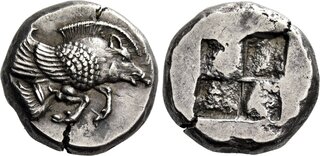| Numismatica Ars Classica > Auction 146 | Auction date: 8 May 2024 |
| Lot number: 2217 Price realized: This lot is for sale in an upcoming auction - Bid on this lot  | Show similar lots on CoinArchives Find similar lots in upcoming auctions on |
| Lot description: Ionia, Clazomenae. Stater circa 500, AR 17 mm, 6.65 g. Forepart of winged boar r. Rev. Quadripartite incuse square with uneven surfaces. Traité I, pl. XII, 14. Jameson 1491. SNG von Aulock 1981. Dewing 2257. Kraay-Hirmer 607 (this coin). Rosen 563. Rare and in exceptional condition for the issue. Struck on fresh metal and of excellent Archaic style. Light old cabinet tone, two minor flan cracks, otherwise extremely fine Ex M&M XIX, 1959, 486; Leu 61, 1995, 137; Tkalec 27 October 2011, 94 and Nomos Fixed Price List Winter-Spring 2014, 26 sales. Clazomenae was reputedly founded by Greeks from Phlius and Cleonae in the Peloponnesus who fled the coming of the Dorians. It became part of the 12-city Ionian League and was originally located on the Ionian mainland, but attacks by Alyattes of Lydia (c. 635-c. 585 BC) caused the Clazomeneans to relocate the city to an island for greater protection. From the new island location, the city grew wealthy through trade with Egypt, but unfortunately neither the more easily defensible island site nor profit from trade could prevent conquest by the Persians following the overthrow of the Lydian kingdom in 546 BC. Like many of the Ionian cities, Clazomenae chafed under Persian rule and in 499 BC rose up as a participant in the Ionian Revolt (499-494 BC). This major rebellion was crushed and Clazomenae was captured by the Persian general Otanes. It is not recorded whether the city suffered additional punishment following the return to Persian domination. The present silver stater was produced at about the time of the Ionian Revolt and was very likely struck in order to hire mercenaries to fight against the forces of the Great King and defend the city. A drachm with the same types occurs in the Asyut hoard, which appears to have closed in the period of the revolt. The winged boar on the obverse was the civic badge of Clazomenae. Here this mythical composite beast has been rendered in beautiful archaic style by its Greek engraver. The ornamental termination of the forepart may perhaps suggest that the type actually depicts a rhyton in animal form. Rhyta were ritual drinking horns often used for pouring sacrificial libations by both Greeks and Persians. Some surviving examples were made into the form of animals so that the wine could be poured into the top of the horn and then seep through the mouth of the animal depicted. Estimate: 12500 CHF |  |



